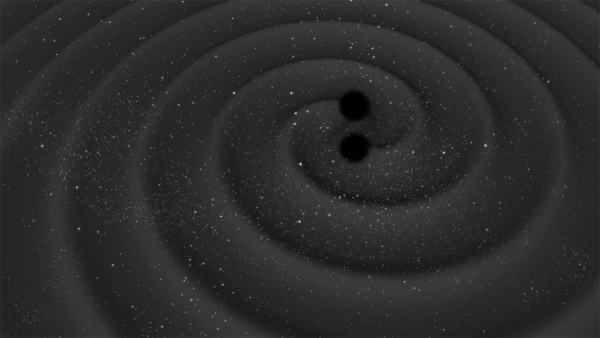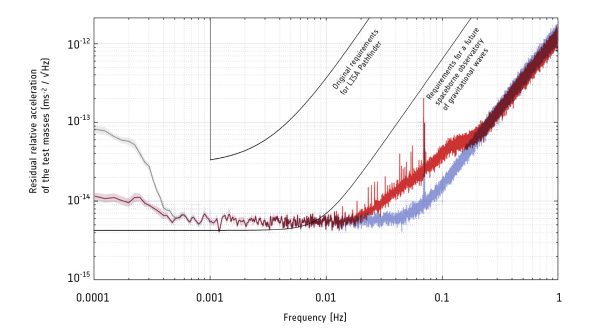The Gravitational Universe
More than a billion years ago, two gigantic black holes collided in a distant part of the Universe. Each black hole contained approximately 30 solar masses. At the moment of collision they rocked the very fabric of the Universe, setting it quivering.
Those disturbances began travelling through space like ripples across the surface of a pond. After 1.3 billion years, they happened to pass through the Earth on 14 September 2015.
At the time of the collision, life on Earth was probably confined to single cell organisms. By the time of their passage, humans had evolved and Albert Einstein had developed General Relativity, a theory of gravity that predicted the existence of these 'gravitational waves'.
Publishing his theory in 1915, Einstein himself thought that developing the technology to detect gravitational waves was probably impossible. The disturbances are only about one-thousandth the width of an atomic nucleus.
Yet, after decades of development, scientists and engineers working on the Laser Interferometer Gravitational-wave Observatory (LIGO), based in the United States, had switched on the latest version of their detectors shortly before the whisper of the black holes passed by.
Although the measured disturbance lasted just 200 milliseconds, it was detected immediately and analysis by scientists from the LIGO and Virgo collaborations showed that it was a textbook rendition of Einstein's prediction.
| The sound of two black holes colliding. Credit: LIGO |
The team also detected a second signal on 12 October 2015. It looked like the merger of two black holes – one 23 solar masses and one 13 solar masses – but the signal was not strong enough for the team to feel confident enough to claim a second detection.
So they went public on 11 February 2016 about the September detection, and history was made. Even as this announcement was being made, the team were analysing yet another possible detection. It arrived at Earth on 26 December 2015, pinging the LIGO detector at 05:38 CET. This time the signal was strong enough for them to be sure.
The gravitational wave had been generated by a pair of black holes, with masses of around 14 and 7 times the mass of the Sun, that collided 1.4 billion years ago. The information about this second discovery was released to the public on 15 June 2016.
On 1 June 2017, LIGO and Virgo scientists announced a third detection of gravitational waves, also from the merging of two black holes. Not long after, on September 27, 2017, the Virgo Collaboration and the LIGO Scientific Collaboration announced the first gravitational-wave signal observed by a network of three laser interferometers. As with the previous detections this was produced by a pair of merging black holes.
Not only do these detections prove that gravitational waves exist, they open up the study of the gravitational Universe.
ESA is no stranger to exploring new windows into the cosmos. Missions that have shown us the Universe at invisible wavelengths of light include Planck (microwaves), Herschel (infrared), XMM-Newton (X-rays), and INTEGRAL (gamma-rays). But to peer into the gravitational Universe is altogether different. It would be the equivalent of astronomers developing a whole new sense.
 |
| Gravitational waves. Credit: ESA–C.Carreau |
Gravitational waves are three-dimensional vibrations in the so-called spacetime continuum. We still do not know what this continuum actually is. It started life as a mathematical framework devised by Einstein to make his concept of gravity as a distortion of space work. Clearly however, the great success of General Relativity, including the detection of gravitational waves, means that the spacetime continuum is real.
Being able to detect gravitational waves gives us a powerful source of complementary information about the cosmos and the celestial objects it contains. Being able to observe them will be like going from watching a silent movie to experiencing a fully surround-sound blockbuster.
Gravitational waves have the potential to show us the most violent events in the Universe. In the case of the black hole collision that was announced on 11 February 2016, three times the mass of the Sun was converted into energy, which was emitted through gravitational waves. Apart from the Big Bang itself, this is the greatest release of energy astronomers have ever seen in the Universe.
ESA has long recognised the potential, and challenge, of observing the gravitational Universe. Some form of space-borne gravitational wave observatory has been studied by the agency since 1993.
The various mission concepts that have been studied have always placed lasers at the very heart of the system to measure small disturbances. They have come to be known by the generic name of Laser Interferometer Space Antenna (LISA).
But testing such a detector can only be done in space because it requires components to be floating freely in the microgravity environment. This means that committing to the full mission straightaway was too risky.
On 3 December 2015, ESA launched LISA Pathfinder. This spacecraft was designed to test the local laser detection system and other technologies needed for a full LISA-like mission.
| LISA Pathfinder performance. Click here for video details. Credit: spacecraft: ESA/ATG medialab; data: ESA/LISA Pathfinder Collaboration |
Even before this mission was launched, ESA decided in November 2013 that the third large mission (L3) of its Cosmic Vision science programme would be an exploration of the gravitational Universe. Its launch is planned for 2034.
In principle, it could be any investigation but it is most likely to be some form of gravitational wave observatory. As such, it would be sensitive to different frequencies of gravitational waves than its ground-based counterparts, and therefore would reveal different celestial events.
For example, although ground-based detectors can see black holes merging, the giant ones – with masses of a million times that of the Sun – that sit at the heart of galaxies will generate gravitational waves of much lower frequency. These cannot be detected with ground-based systems because seismic interference and other sources of noise overwhelm the signals. For this reason, space-based observatories are needed.
Shortly after the decision of the scientific theme for L3 was announced, ESA set up the Gravitational Observatory Advisory Team (GOAT). In March 2016, they released their final report into the feasibility of a LISA-like mission. Their deliberations took into account the successful detection of gravitational waves from LIGO, and the first results from the LISA Pathfinder mission, which were successful.
The GOAT report categorically states that a space-borne gravitational wave observatory is possible and that laser interferometry between free-falling test masses is the detection method of choice. The success of LIGO and LISA Pathfinder show that such systems are in an advanced state of technical readiness.
On 25 October, ESA issued a formal call for proposals from the scientific community. On 20 June 2017, ESA's Science Programme Committee selected the LISA concept for the first space-based gravitational wave detector.






